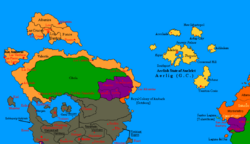San Martin
From MicrasWiki
Jump to navigationJump to search

|
This article refers to a micronation which is defunct and no longer exists. You can help make the article reflect that or ask on the talk page for further information.: |
| |||
| Motto: Libertas Suprema (Audente: Liberty Supreme) | |||
| Anthem: | |||

| |||
| Map versions | Version 6.8.1[1]-15.9.8[2] (Above map version is San Martín in lighter orange, in the island of El Dorado and the northern coast of the Cibolan continent in version 6.8.6[3], representing San Martín at its independent zenith before its annexation to Alexandria in 1508 AN.) | ||
| Capital | Los Santos | ||
| Largest city | Altamira, Las Cruces, Ponce, Las Venturas, San Sebastián, Los Camellos | ||
| Official language(s) | Martino Alexandrian | ||
| Official religion(s) | Church of Alexandria | ||
| Demonym | Martino, San Martinean, Sanmartinense | ||
| - Adjective | Martino, San Martinean, Sanmartinense | ||
| Government | (1) Constitutional federal republic (1488 AN-1500 AN) (2) Constitutional federal imperial monarchy (1501 AN-1508 AN) (3) Province of Alexandria (1508 AN-1651 AN) | ||
| - | |||
| - Legislature | |||
| Establishment | 1488 AN | ||
| Area | |||
| Population | |||
| Currency | |||
| Calendar | |||
| Time zone(s) | |||
| Mains electricity | |||
| Driving side | |||
| Track gauge | |||
| National website | |||
| National forum | |||
| National animal | |||
| National food | |||
| National drink | La Jueza Rum | ||
| National tree | |||
| Abbreviation | |||
Etymology
History
Republic of San Martín
Martíno Civil War
Empire of San Martín
- House of Ramirez
- House of Carrillo
Alexandrian Province of San Martín
- House of Carrillo
- Third largest & most populated Alexandrian province after Baudrix and Valenciennes.
Geography
Politics
Economy
Demographics
Culture
See also
References
| Political divisions of the Empire of the Alexandrians | |||||
|---|---|---|---|---|---|
| |||||

